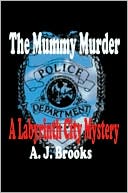

 |

|

The average rating for The Mummy Murder based on 2 reviews is 4.5 stars.
Review # 1 was written on 2010-09-29 00:00:00 Rita Burns Rita BurnsWhen I finished this novel I realized two things: first, that I'd just read something outstanding and second, that (as it says on the dustjacket blurb), Peter Temple is a "master writer." This has to be one of the best and most beautifully-written crime fiction novels I've ever read, and I can't wait to get back to his next novel, Truth, which I've only just started and am already loving. Joe Cashin is a homicide detective who's recuperating from physical and emotional trauma in the small town of Port Monro on the south coast of Australia. Port Monro is not his normal beat; he's been posted there to put some distance between himself and the events that left another policeman dead and himself hospitalized. It's a perfect place for Joe; he spends a great deal of his time with his dogs, and to get his mind off of his recent troubles, he's rebuilding an old ruined house, as well as himself, with the help of a "swaggie" named Rebb. But his peace is shattered when he finds himself smack in the middle of an intriguing crime: one of the town's wealthiest citizens has been found dead and the police in charge of the investigation want very badly to pin the murder on three indigenous teens. Cashin is called to help with the case, but he's not convinced that the racially-prejudiced local police are correct in their assumptions. What sets this novel apart, making it an outstanding read, is not so much the plot, which is believable and well executed, but the writing. The reader is plunged into an Australia that is divided over racial issues, plagued by corruption among government and local officials, divided between development that would create new jobs but would wreck the environment and the landscape. While a reader can perhaps find those sorts of problems in his or her own country, Temple keeps it Australian through his use of the local lingo (and then puts a glossary of Australian terms in the back for reference-- which is itself quite funny in parts), description of little things like food, and especially in terms of a sense of place. The small community's colorful characters and the small-town problems he's involved with ("a man about a neighbour's tree, the report of a vandalised bench...") set the stage, as do the vivid descriptions of the landscape. Take, for example, the description of Cromarty's Kettle, located in the Rip: ...the huge sea, the grey-green water skeined with foam, sliding, falling, surging, full of little peaks and breaks, hollows and rolls, the sense of unimaginable power beneath the surface, terrible forces that could lift you up and suck you down and spin you...the power of the surge would push you through the gap in the cliff and then it would slam you against the pocked walls... as well as the descriptions of the small pubs, truck stops, the "roads smeared with roadkill ---" or the road to Port Monro: the "pocked junctions where one or two tilted houses stood against the wind and signs pointed to other desperate crossroads." The characters are also very well developed, especially Joe Cashin -- a broken and damaged, yet decent man trying to get it all back together, whose backstory and troubled past (including an unstable childhood) are unfolded little by little, interwoven with his present. He doesn't mind solitude, although perhaps not so completely as he would have you believe, and he's the consummate professional, yet willing to go with his intuition when the situation demands. This is an excellent book, and although I've focused mainly on the writing here, the story itself will also keep you turning pages until it's over. And then, I think, you'll be left wanting more. |
Review # 2 was written on 2013-02-16 00:00:00 Todd Burrow Todd BurrowChallenge: review "The Broken Shore" without mentioning how "Australian" it is. There are a lot of reviews on this site expressing frustration with The Broken Shore for its dialectical idiosyncrasies. I won't take this opportunity to express my frustration at the way in which shit rolls downhill, obliging Australian readers to maintain a familiarity with British and American dialects, but rendering Australian dialects "unreadable" to our northern cousins. I won't mention that gripe at all. What I can say about the writing is that it is the best representation of everyday Australian speech I have ever come across. The dialect is there in all its glory - oblique, ungrammatical, sweary, replete with bold references to taboo subjects and clever euphemisms for the most innocuous ideas, often dreamt up for the speaker's own amusement. Foreign readers - American readers in particular - should note that the word "cunt" is often employed in this book and in everyday speech in Australia. It's not a malicious word, more often than not, and is rarely accompanied by the sexist/misogynist connotations that it carries in other contexts. If it offends or shocks you, try substituting "bloke" for "cunt". Read the original sentence the same way you would read it with the substituted word; don't dwell on the language that offends you; read it as it was intended. |
CAN'T FIND WHAT YOU'RE LOOKING FOR? CLICK HERE!!!